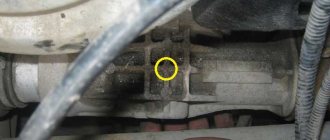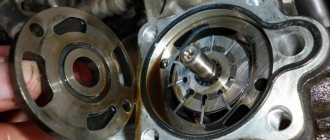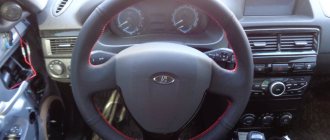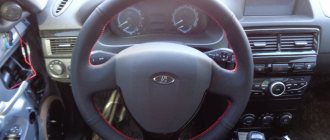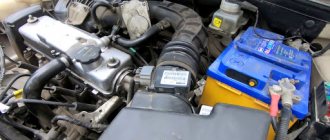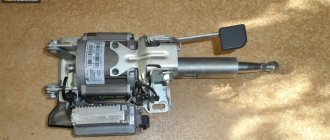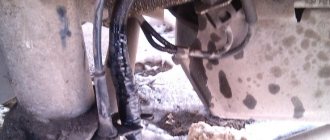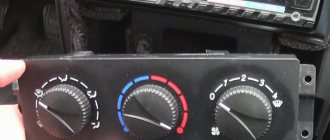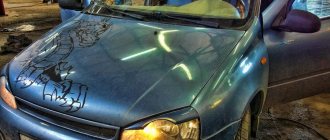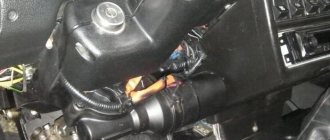Today, every Priora is equipped with electric power steering (EPS), and this also applies to basic configurations. At the beginning of the car's release, the unit came as an additional comfort option. Owners of this model know that the unit often jams and fails. The power steering has become the weak point of the Priora, but if necessary, repairs can be done with your own hands. In this material we will take a detailed look at what the EUR is, what breakdowns occur in this unit and how to fix them yourself. You should take on the job only if you have experience in servicing a car, since when replacing it we will have to disassemble half of the dashboard.
Purpose of the unit
Due to the operation of the ESD, the load and force on the steering wheel are reduced when making a turn. The unit greatly facilitates driving, and at high speed it does not allow dangerous maneuvers.
The unit includes the following components:
- Steering wheel;
- Column;
- Shaft;
- Electric motor;
- Steering mechanism;
- Electronic control unit (ECU);
- Torque sensor.
When turning, the electric power steering is activated. The torque is provided by an electric motor, which is present in the EUR design. The torque sensor measures the indicator and sends it to the ECU. Depending on the angle of rotation, the block calculates how much power needs to be given to the motor. The switch located under the steering wheel contains a device that determines the angle of rotation. The torque and rotation sensors transmit data to the ECU, which “determines” whether the electric motor is running at the desired speed.
On previous generations of VAZ cars, a hydraulic booster was installed; it gave almost the same force in all rotation ranges. As for the electric power steering, the degree of force depends on many factors - the speed of rotation of the steering wheel and its angle, the speed of the power plant, the speed of movement.
Malfunctions and their symptoms
Undoubtedly, the electric booster is a more reliable unit than a device running on hydraulics, but malfunctions also appear in the power steering. If they are detected, repairs must be carried out immediately, since the safety of the driver, his companions and other road users depends on the operation of the amplifier.
Complete failure of the EUR
As practice shows, this unit does not have many faults; breakdowns occur in the same parts. The first thing worth considering is the complete failure of the ESD. When you turn off the amplifier, you need to check the on-board computer screen; most likely, you will see a code there indicating a malfunction in the unit. But sometimes it is possible to determine when an amplifier is turned off only in practice.
We perform the following actions:
- Turn off the engine and turn the steering wheel in different directions several times;
- We repeat these steps, but with the engine running;
- Has the steering effort changed? This means the node has completely shut down.
Even with the ESD not working, you can continue driving, but this is not recommended. The driver needs time to get used to driving with the help of an amplifier. It is better to immediately begin diagnostics and determine which component requires repair or replacement.
Sometimes the amplifier and speedometer stop working at the same time. The cause of this defect is a speed sensor that has failed. Taking a look at the electrical diagram, you will understand that these three elements are connected. The torque sensor supplies data to the control unit, it compares it with speed and determines the force. If the cause is the speed sensor, then the repair consists of checking the wiring that leads to this element. It is also worth checking the wires connecting the sensor to the speedometer and power steering. If there are no breaks in the switching, then the sensor should be changed.
Low voltage in the car network can also lead to the ESD turning off. Faults should be looked for in the wiring insulation. If it is damaged, short circuits will appear in the network. Also, violations in insulation lead to malfunction of the generator. To troubleshoot the problem, check the wiring and generator. The torque sensor contains many contacts, which, if heavily soiled, help turn off the power steering. In this case, repair means disassembling the unit and cleaning the contacts of the torque sensor.
see also
Unpredictable steering behavior
The driver is driving on a flat road, the position of the steering wheel does not change, and suddenly the car turns to the side. Such unpredictable behavior of the power steering requires urgent diagnosis, since at the most inopportune moment the electric power steering of the Lada Priora can send the car to the side of the road or into the oncoming lane. In such a situation, you should stop driving and turn off the amplifier. To do this, we need to remove the fuse, which is responsible for supplying voltage to the amplifier.
To remove this fuse, you need to do the following:
- The mounting block cover is located at the driver’s left foot;
- We turn the clamps and unclip the fasteners;
- You will find the block where the required fuse is located near the expansion tank;
- Feel free to take out fuse F5 (50 A) - it is responsible for providing the power supply circuit to the power steering unit.
Fuse box location
If you suspect that a fuse has blown and you want to check it, then the question arises: where is the Priora electric power steering fuse located? The control mounting block is located to the left of the steering wheel. Its opening scheme is simple. All you need to do is turn the three latches 90˚ and remove the cover, as shown in the photo, and you get to the brain stuffing of the car.
Here you can check and replace the failed fuse, then close the lid by pressing it tightly and snapping the three latches back 90˚ in the opposite direction.
You can carry out diagnostics and minor repairs to the Priora's electric power steering with your own hands. To do this, it is enough to determine what caused the failure and fix the problem, following our advice. It is better to entrust a complete replacement of the electric amplifier to professionals.
Today, every Priora is equipped with electric power steering (EPS), and this also applies to basic configurations. At the beginning of the car's release, the unit came as an additional comfort option. Owners of this model know that the unit often jams and fails. The power steering has become the weak point of the Priora, but if necessary, repairs can be done with your own hands. In this material we will take a detailed look at what the EUR is, what breakdowns occur in this unit and how to fix them yourself. You should take on the job only if you have experience in servicing a car, since when replacing it we will have to disassemble half of the dashboard.
Replacing the EUR
So, you need to replace the electric booster on the Priora or simply check the condition of its contacts. In any case, repair involves complete removal of the unit. Prepare the necessary tools:
- Chisel and hammer.
- Deep head for 8 and 13.
- Extension and ratchet, alternatively you can use a wrench.
It’s quite easy to remove the amplifier itself with your own hands, but in order to get to its mounts and the control unit, you will need to remove many parts of the dashboard: the steering wheel along with the airbag, the casing and the ignition switch. Once these components are removed, repairs to the amplifier can begin.
Step-by-step instruction
- We take the “eighth” head, put on the ratchet and remove the contact group, as shown in the photo below;
Now you can study the contacts in detail and, if necessary, make repairs. If you know that the main components (control unit, motor) have failed, then you need to replace them. Installation of a new device occurs in the reverse order. The DIY repair is complete.
There are two types of power steering: electric power steering and hydraulic power steering. Priora was composed of both. The price is higher for EUR, but sometimes it doesn’t work. The electric power steering of the Priora car has an analogue of the AENK-K, but it is 2 times more expensive than the standard power steering of the Lada Priora. With Eur, the steering wheel of a Priora car becomes much lighter. With gur you feel the road. Compared to the Eur, the Priora has more spare parts, is attached to the pentosin liquid, it needs to be monitored, topped up - so that starvation does not occur! The price for replacement also differs depending on the system, the EUR is easier to replace and can be called with a diagnostic connector, so this is the electric motor. Electric power steering (EPS) for Priora comes in two types: geared and gearless - and the first is an outdated technology that was installed on the first Priora - read about it in the article below.
The presence of electric power steering on the Priora has become an indispensable requirement for every car enthusiast. This is justified: once upon a time, the owners of domestic “Zhiguli”, from the first years behind the wheel, learned to turn the steering wheel with both hands with maximum effort. On modern cars, you can turn the steering wheel even on the spot in a snowdrift with one hand, therefore, when choosing a Lada Priora in the cabin, electric power steering was the first mandatory item in the package for many. Later they began to install steering wheel and power steering in all configurations.
Electric power steering is not installed on the Priora in all trim levels - the simplest one has power steering. Knowing the power steering device and being able to “bring it to life” is the direct responsibility of the Priora driver, who loves his car.
Why the electric power steering does not work on a Priora, possible reasons
Next, some reasons will be listed due to which the electric power steering on the Priora stopped working.
EUR does not pass self-test
When the ignition is turned on, the electric power steering does not undergo self-monitoring and turns off on its own. Thus, it will not interfere with the driver and contribute to the creation of an emergency situation while the car is moving. If the EUR does not pass the self-testing procedure, the repair will cost you a pretty penny.
Speed sensor faulty
The point here is that the electric booster scans data about the speed of the car from the speedometer, which, in turn, receives signals from the speed sensor. If the sensor fails, false information begins to be supplied to the speedometer. The situation causes the electric booster to spontaneously deactivate. The problem can be solved simply - replace the sensor with a new one.
Battery problems
Quite often, a malfunction of the EUR, which requires a voltage of 13.5 V for its uninterrupted operation, is accompanied by its drop. Here, the first thing you need to do is diagnose the battery; the problem may be there. By the way, it would be a good idea to check the generator.
Wiring problems
Another reason why the EUR does not work on a Priora may be damaged wiring. Weather disturbances such as frost, heat, and precipitation can also aggravate the situation. If they replace each other and the EUR starts to act up, then you simply cannot do without researching the wiring. You need to check the soldering and insulation, perhaps there is a short somewhere.
EUR control unit
A completely miraculous situation can happen when the wheels of your car change direction on their own, without your participation. The reason is simple - the filling of the electronic control unit of the power steering unit is “weird”, on which, for the sake of economy, the developers did not work seriously enough. At the same time, such a problem should not arise on copies of recent model years. In any case, if you notice that the electric amplifier has begun to live its own separate life, immediately contact a service station for help.
Owners of the Priora model should also remember that the electric power steering on their car does not work all the time. The electric motor takes on the most load at low speeds or when the car is stationary. The electric engine is loaded to a minimum only at high speeds, and this is where an unexpected circumstance makes itself felt. The fact is that when the speedometer needle touches 110 km/h, the EUR will stop performing its direct duties. This is noticeable immediately, as the force on the steering wheel becomes maximum. By the way, owners of Lada Kalina are even less fortunate; there the electric booster is de-energized already at 60 km/h.
So, we figured out why the electric power steering turns off on a Priora, and now it’s time to move on to diagnosing problems.
Why is it needed and its device
ESD is an electrical mechanism that reduces the control force with which the driver turns the steering wheel. It turns out that this cunning device takes on most of the effort, leaving the driver responsible for the safety of the maneuver. The design of the EUR is as follows:
- Electronic control unit and electric motor;
Controller and peripherals
- Steering wheel;
- Output/input shaft;
- Studs, nuts, bolts, etc.;
- Bracket;
- Steering rack;
- Connections;
- Steering wheel tilt adjustment lever.
It works like an ordinary electronic mechanism - for example, like a prosthesis: receiving data from sensors about the resistance of the road surface, vehicle speed, crankshaft speed, the force that the driver applies to turning the steering wheel, the “brain”, the electronic control unit, delivers the electric motor to sufficient power to so that the car can be controlled with one finger.
The steering column becomes almost weightless, and does not even give off the vibration familiar to many from prolonged holding in the extreme position.
Disassembling the steering column
For this procedure you need to prepare:
- wrench 8 (socket);
- at 13 (end);
- Phillips screwdriver.
Before starting work, it is important to disconnect the battery. To do this, it is enough to remove the wire from the negative terminal.
- remove the steering wheel;
- the plastic shields are removed from the column (they are held on by two screws and clamps each);
- dismantle the lower part of the lining by unscrewing 4 bolts;
- disconnect the wires from the lock and turn signal switch, etc.;
- using a 8 key, partially loosen the clamp holding the above-mentioned devices and remove them completely;
- pull out the connector terminals of the EUR controller;
- remove the plastic cover.
Then all that remains is to unscrew the nuts located at the bottom (it is not necessary to remove them - just loosen them). Here you will need a key for 13. After this, direct access to the electric amplifier will open. It is removed after the bolt holding the joints of the shafts - intermediate, splined - is unscrewed, as well as the nuts securing the motor itself.
Standard electric amplifier - article number and price
On the market you can find geared (outdated) and gearless EPS (electromechanical power steering) for Priora. It is worth concentrating on the second option, there are reasons for this:
Fast request processing: the “intermediary” - the gearbox - disappears - the ECU copes faster with the driver’s commands; More durable. The gear transmission of the gearbox can break at an inconvenient moment, but in a gearless electric power steering system the moment is transmitted directly to the steering rack. The noise level is reduced. The article number of the gearless EUR for the VAZ 2170 Priora is 2172-3450008-02. The price ranges from 20,000 to 25,000 rubles. The cost of a geared EUR is two thousand lower, but is it worth it - to skimp, pay less money, and then deal with frequent breakdowns?
Advantages and disadvantages over power steering
Power steering (power steering) was once the ultimate dream for many, but you had to tinker with it - which only cost the constant addition of working fluid to the reservoir, plus a thrifty attitude towards the mechanism.
Benefits that the owner of a Priora with EUR receives:
More reliable mechanism. It's simple - there is nothing that often breaks (pulleys, hoses) or runs out (liquid). In addition, diagnostic data on faults can be obtained from the ECU. Installation, according to the manufacturer, will take no more than 1.5 hours - with wires everything will be much easier than with connecting hoses. In addition, you don't have to climb into the engine compartment. Passive impact safety Adjustability. Initially, after installation, the force will increase with increasing vehicle speed. This can be changed by reprogramming the data in the ECU - for example, reducing the force from the mechanism with increasing speed. Energy saving. The electric motor inside does not work constantly - it starts only when the driver starts to turn the steering wheel.
It would be wrong to remain silent about the shortcomings:
You don’t “feel” the road - power steering makes the car more sensitive, an experienced driver appreciates this. The EMUR mechanism (electromechanical power steering) is more expensive than power steering. Basic faults
The best plan is to identify the malfunction of the device before starting to move, otherwise a surprise while driving can lead to surprises. It turns out that while driving a person will continue to apply little effort to turning the steering wheel, which is why the car can go straight during the intended turn.
When turning on the ignition, always wait until all the sensor lights come on. The EUR sensor in the form of a steering wheel will also light up. Within two seconds, the electronic control unit diagnoses the entire system; if after this time the sensor does not burn out, the ECU has found a fault.
Not every malfunction of the ECU is reflected on the dashboard:
Shocks in the steering wheel; When the engine is off and when the engine is on, the hand effort is almost the same. As mentioned earlier, the ECU controls everything. Of course, you can find out about any breakdown through the diagnostic connector, to which you can connect yourself. It may produce the following error codes that relate to the EUR:
If the electric power steering on a Priora does not work, and it is not even possible to connect to the diagnostic connector, you can try the old “old-fashioned” method:
Insert the key into the ignition lock. In the eight-pin connector of the control unit, close contacts 6 and 7 (the first one is near the latch, upper right); Turn on the ignition, but do not turn on the engine. In this case, you need to look at the dashboard - at the place where the EMUR icon lights up.
Battery problems
Based on this, we can draw the first conclusions about the cause of the breakdown. A common cause of malfunction is low voltage in the on-board network. The fact is that for the amplifier to function, a supply voltage of 13.5V is required.
First of all, we test the battery, if everything is fine with it, then we’ll look into it further. The problem may have occurred when you removed the battery for charging. To make the electric booster work again, turn the wheels to the extreme position and back 5-6 times, very often this is enough to resume operation.
The decoding is as follows:
- 1 long 1 short System OK;
- 1 long 2 short No engine speed signal;
- 1 long 3 short Torque sensor faulty;
- 1 long 4 short EMUR motor malfunction;
- 1 long 5 short Faulty steering shaft position sensor;
- 1 long 6 short Malfunction of the EMUR engine rotor position sensor;
- 1 long 7 short Malfunction of the car's electrical system (below 10V or more than 18V);
- 1 long 8 short Malfunction of the EMUR control unit;
- 1 long 9 short Vehicle speed sensor malfunction;
Removing and installing electric booster - tools
Even manually diagnosing something with an EUR will be difficult - one way or another, you will have to remove it. To do this, you should prepare and get:
- Hammer;
- Chisel;
- Extension;
- Driver (ratchet);
- Heads for 8 and 13.
Let's sort it out
- Disassemble and remove the steering column. Remove the negative terminal from the battery;
- Using the eighth head, remove the contact group;
- Disconnect all wiring from the gray metal block. Each wire is under a lock, so handle them carefully, try not to damage the contacts;
- Disconnect the steering rack and cardan mounts by removing the bolt. Using a chisel and hammer, loosen the universal joint;
- Unscrew the four nuts that secure the amplifier to the body;
- Pull out the EUR.
To install the EUR, all steps are performed in reverse order. It is highly recommended that during dismantling you remember (better - take a photo!) the connections of all wires so that the installation goes smoothly the first time.
Hello everyone, there is a problem with the power steering, the car was standing in the cold, warming up, sat down, everything was fine, I arrived at the garage and didn’t turn it off, well, it worked for an hour, then when I turned the steering wheel all the way, there was a click, the power switch turned off, turned it off, started everything back to normal, and so on for a couple of days, then it stopped working altogether! What could it be?
Comments 65
It works flawlessly for me in the summer, but as soon as the cold weather starts, the engine switches off, I give up and drive like this, I don’t have the money to pay 15-16 thousand rubles for it.
Please tell me what happened? I removed the torpedo for the ShVI, put it back, the EUR stopped working, the front is intact, no oxidation chips, also without oxidation, these are the errors
Mine was also buggy, and then completely died. Everything was as in the description, it turned off after a click and turned on when the engine was restarted. And at one point it stopped working completely. I advise you to urgently go to a diagnostician. They say in such cases the steering wheel can become stuck at any moment, God forbid, at speed.
The electric power steering switched off on the Priora reasons
Guys, who knows, from time to time the EUR turns off, when I turn the wheels, a knock appears and a light comes on on the dashboard, the EUR turns off! I turn off the car, start it again, the EUR works until I start to twist the steering wheel! Has anyone had this happen to me?! Where to drip? or does the EUR need to be replaced?
Comments 21
I had the same problem, I started saving money for a new EUR, because... All the electricians in the city say they are replacing it. I decided to remove the EUR control unit, it turned out that the contacts had simply moved away from the back of this unit) I inserted it back and now everything is fine.
I have the block itself, the keys on this block flew off
Here on the drive there was a guy writing about the EUR. He took it apart and it turned out that the wires were frayed. Maybe it's the same for you. It doesn't work for me either. But my hands can’t get around to sorting everything out.
Yes, I also thought about this, as it turned out, the EUR control unit, but it is not sold separately, so for now I drive like this, they are already getting used to it, I think that I will still buy it from a disassembly site, and they are also sold there like pie
In general, there is an error: No engine speed signal! I don’t even understand where to go, and how is this related to the EUR?!
An open circuit of the steering shaft position sensor, or a break in the sensor itself. EUR for replacement. Pull out the red EUR fuse from the main block and drive like that, save some money. I've been driving with this breakdown for 6 years now))).
The steering wheel is so tight, not like on a 10, you’ve probably already pumped up your arms in 6 years?!)))
Tighter, bigger wheels, 3 degrees castor. It's only unpleasant when turning around in place. You don't notice it while moving. But I save on the gym))
An open circuit of the steering shaft position sensor, or a break in the sensor itself. EUR for replacement. Pull out the red EUR fuse from the main block and drive like that, save some money. I've been driving with this breakdown for 6 years now))).
So, there are no problems driving like this, what do you mean there won’t be any problems with the rack?
Nothing, there in the EUR the shaft is direct from the steering wheel to the rack. There's just no gain, that's all.
Tell me, I did the diagnostics, there are no errors at all, is this possible?
No. When you turn off the EUR, an error appears, since the lamp on the tidy lights up. It should be clearly visible during diagnosis. Here you need to look at two things - voltage sag and the actual errors of the EURA sensors. In both cases, it can turn off. When the steering wheel rotates in place, the windings consume up to 32 A of on-board voltage. If at this moment you have a drawdown for some reason, the EUR will turn off. And this will be visible in the diagnostics if the voltage parameter is displayed on the screen. And a break in the shaft position sensor circuit is also immediately detected, you just have to turn the steering wheel for the EUR to turn off. The very second the amplifier turned off, the diagnostician told me the reason.
Hello everyone, after a year and a half I solved my problem of turning off the EUR. The problem first appeared during strong vibrations, it lasted for about 4-6 months, later the EUR began to turn off on its own, for example, when turning the steering wheel to the right or left. I always had to turn off and start the engine to get the EUR to work again. Exactly a year ago - last summer it turned off for me for about a month and did not turn on at all. I did diagnostics and it showed that there was no signal from the torque sensor. After surfing the Internet, I realized that the problem is common and cannot be repaired. I already thought I would buy a new unit at that time the EUR cost 15 thousand rubles. But first, I decided to take it off and disassemble the electric motor and look at the condition of the tracks (someone said that the track could have burned out or something like that) I took it off, but as soon as I started to take it apart it started to rain, spitting on this idea, I put everything back together and I put the EUR in its place, started the engine and the EUR suddenly started working (joy knew no bounds), but after some time it started to malfunction again. A little later, I noticed this feature: if the EUR turned off, it was enough to move the plug that connects the electric motor to the EUR control unit (brains in short) and then everything began to work like clockwork. I thought that the “mother” terminals inside this plug had expanded, which contributed to the disconnection of the unit during strong vibrations, then I again removed the EUR and bent the terminals so that the surface contact of the terminals was maximum - The problem partially went away, but the EUR still turned off, but with less frequency . Further, turning off the power steering infuriated me more and more often, the next “solution to the problem” was the idea of spreading the plug to the side using a long bolt - fixing the plug inside the control unit became as motionless as possible. This “rework” was enough for 2 months. After that, nothing helped. And after a while, I again removed the EUR (with my experience, it took about 10 minutes to dismantle it) And I decided to cut off the plug and throw it away (which I later regretted, then you’ll understand why) there are 3 power wires, I soldered the terminals to them “ mom” stuck them into the block, everything worked, but in the evening the steering wheel turned again with great effort. Then I realized that the problem was not in the plug itself, but in the socket where it is inserted, that is, in the control unit itself, removing it and disassembling it did not reveal any damage, I rang everything that was possible, but everything was fine, but still something was wrong It was not so, I found another control unit at the auto analysis, connected it and everything WORKED! and it works absolutely without problems.
PS, how many people have already been thrown out by relatively working EURs, and the problem largely lay in the control unit. All the diagnosticians unanimously shouted that the problem is in the electric motor in the torque sensor, but the TORQUE SENSOR is ALIVE, all signals during diagnostics pass through the EUR CONTROL UNIT, and it cannot pass the signal to the electric motor, thereby giving an error of a malfunction of the torque sensor or something else!
My advice to you, prior guides, if you have such a problem or God forbid you have one, do not trust diagnosticians (who say that the problem will go away if you change the EUR assembly, the problem will go away if you change the car) first look for exactly the same control unit - This is the first thing you should do before buying a new unit. All control units have different firmware, you will need exactly the same one as on the electric motor itself, I had version 670, you may have a different one, the firmware version is written both on the control unit and on the electric motor itself! Good luck to all ! I hope my experience will help at least someone.
- Lada Priora: main problems of electric power steering and their elimination
- How to determine that the EUR needs repair
- Main malfunctions of electric power steering and their causes
- How to repair the EUR yourself
- EUR for Lada Priora: faults and solutions
- Operating rules for electric power steering, extending the life of the power steering
One of the most problematic areas of the Lada Priora is the electric power steering. That is why repairing electric power steering is a common problem faced by Priora owners. If you find that the EUR on the Priora does not work, then immediately contact a specialist or do the repairs yourself. Most often, the electric power steering of the Priora has two causes of malfunction.
How to determine that the EUR needs repair
The electric booster on the Priora does not work very often. It refuses to work on both new and used cars.
If a problem occurs with the electric power steering, a yellow button on the dashboard lights up, with a steering wheel with an exclamation mark on it. This button notifies you of malfunctions or failure of the electric power steering.
You can drive the car without the help of an electric booster. To do this, you just need to pull out the power steering fuse, which is located to the left of the steering wheel. Malfunctions of the EUR on a Priora should not scare you, since this malfunction can be eliminated even on your own.
Main malfunctions of electric power steering and their causes
The electric power steering on a Priora fails for the following reasons:
1.When the ignition is turned on, the ESD does not undergo self-monitoring and turns itself off so as not to interfere with the driver and not create an emergency situation on the road. In this case, repairs will be expensive.
2. The electric power steering on the Priora does not work due to a malfunction of the speed sensor. The EUR scans the vehicle's speed from the speedometer, which receives data from the speed sensor. When a sensor breaks down, it begins to provide incorrect information. Then the EUR turns off spontaneously, since it does not know the exact speed of the car. In this case, repair of the electric amplifier is carried out by replacing the sensor.
If the electric power steering on a Priora does not work, a flashing error on the dashboard will immediately let you know.
How to repair the EUR yourself
The electric power steering of the Priora has several causes of malfunction and one way to solve them. For repair you will need:
- Head for 8 and 13 mm
- Ratchet or crank
- Extension
- Hammer
- Chisel
EUR for Lada Priora: faults and solutions
First you need to remove the steering column cover, then remove the ignition switch and steering wheel. In the case of the ESD on a Priora, faults should be eliminated step by step.
Next, using
an 8 mm socket and a ratchet, unscrew and remove the contact group. It must be completely removed from the shaft so that it does not interfere. Next, you need to disconnect the power wires from the EUR control unit. Each plug has its own lock, so you need to work carefully so as not to damage them.
Next, you should unscrew the coupling bolt at the universal joint mounting with the steering rack. Using a chisel and hammer, slightly expand the coupling “collar” of the cardan.
After this, you can unscrew the nuts securing the EUR to the body. There are two nuts at the front and two more at the bottom. When all the nuts are unscrewed, the EUR needs to be removed from the steering rack shaft. We replace it with a new one and assemble the mechanism in the reverse order.
Repairing the Priora electric power steering with your own hands will significantly save your budget.
Operating rules for electric power steering, extending the life of the power steering
The Priora EUR often does not work due to its incorrect use. To ensure that the electric booster on the Priora does not fail, simple rules should be avoided:
- Do not leave the steering wheel in extreme positions for a long time. It is impossible to move away sharply with the steering wheel in the extreme position.
- When parking or turning a car, you do not need to hold the steering wheel in the extreme position for more than 4-5 seconds.
- Regular technical inspection of the Priora ESD mechanism will identify malfunctions and help eliminate them immediately.
- You should pay attention to the strange sounds that the electric amplifier makes.
Subscribe to our feeds on social networks such as Facebook, Vkontakte, Instagram, Twitter and Telegram: all the most interesting automotive events collected in one place.
